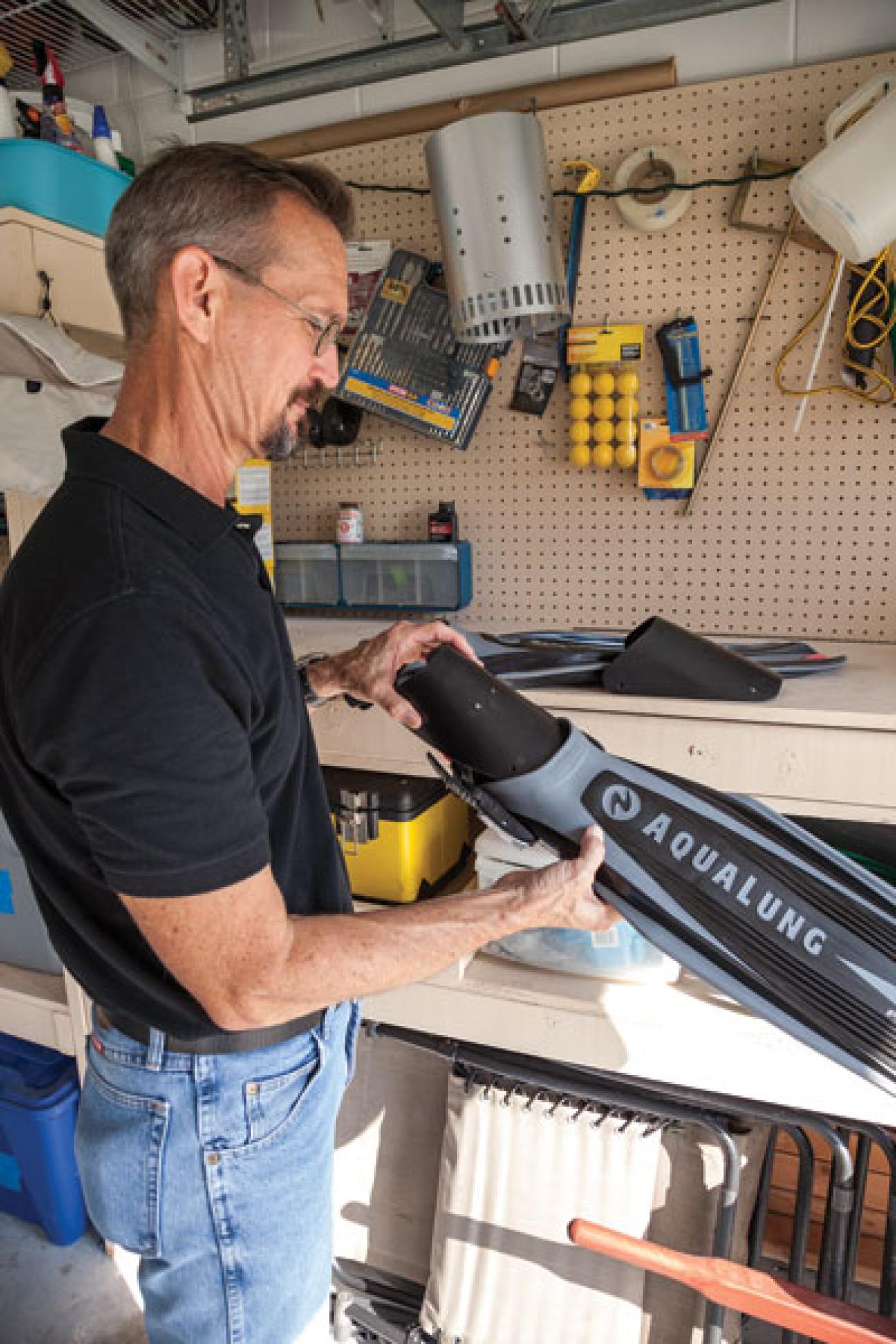Understanding the Different Types of Scuba Diving Fins

Choosing the right fins
ScubaLab director Roger Roy gives tips to divers on buying the right fins.
Carrie Garcia
ScubaLab's Gear Guide is filled with the cream of the crop in BCs, dive computers, regulators, underwater cameras, masks, snorkels, fins, wetsuits, drysuits and everything else you need to complete your dive kit. It also has gear maintenance tips, explanations about the important features on every category of gear, and a behind-the-scenes look at how ScubaLab tests gear. One of the most-popular sections in the Gear Guide offers tips on what to do with your gear after you buy it — what we call "Out of the Box." Here: How to choose the fin that's right for you.
With fins, there is a lot to consider before you buy and take them out of the box. Here are some things to keep in mind:
Full-Foots vs. Open-Heels
Full-foot fins are much lighter than comparable open-heel fins. They also create less drag because there aren’t any dangling straps. They tend to have shorter, more-flexible blades too, making them easier to kick underwater. Because full-foots are designed to slip over a bare foot, you don’t have to wear a spongy neoprene bootie. This enables the foot pocket to grip the foot firmly and completely, allowing for the more-efficient transfer of energy from foot to fin blade.
Getting a perfect fit in a full-foot fin is critical to comfort and efficiency because the foot pocket can’t be adjusted. If it’s too small, the foot pocket will crush your toes; too large, and it will fly off your foot when you kick.
Finally, because you aren’t wearing booties, your feet have no protection with a full-foot fin. This can cause problems when you remove the fin to climb a boat ladder or trek across a rocky beach.
While exceptions are numerous, in warm-water destinations where divers wear less gear, full-foot fins tend to be popular; in cold-water locales, open-heel fins are preferred.
Splits vs. Paddles
Split fins slice through the water with minimal resistance, because rather than pushing against the water with brute force, their flexible blades, when engaged in an up-tempo flutter kick, actually generate lift along with a jet-propulsion effect, similar to a boat’s propeller. The faster the propeller turns, the more propulsion is generated. In other words, with split fins, power comes from the speed of a diver’s kick rather than the force of the kick.
However, due to the principles of the design, the best kick for a split fin is a narrow, rapid flutter kick. Not all divers like to employ this kind of kicking action. For them, a paddle fin is probably the better choice.
Traditional paddle fins tend to have stiff blades that require more leg muscle to get them moving. These are designed for divers who want lots of feedback in their kick. Modified paddle fins offer innovative approaches to connecting blade to foot pocket, cutaways in the upper portions of their blades, and soft center panels. They tend to be more flexible than traditional paddles, making them easier on the legs and ankles. These days, the best modified paddles can compete head-to-head in comfort and performance with the best splits.
For the latest ScubaLab gear test reviews, go to the Gear section of our website.

Carrie GarciaScubaLab director Roger Roy gives tips to divers on buying the right fins.
ScubaLab's Gear Guide is filled with the cream of the crop in BCs, dive computers, regulators, underwater cameras, masks, snorkels, fins, wetsuits, drysuits and everything else you need to complete your dive kit. It also has gear maintenance tips, explanations about the important features on every category of gear, and a behind-the-scenes look at how ScubaLab tests gear. One of the most-popular sections in the Gear Guide offers tips on what to do with your gear after you buy it — what we call "Out of the Box." Here: How to choose the fin that's right for you.
With fins, there is a lot to consider before you buy and take them out of the box. Here are some things to keep in mind:
Full-Foots vs. Open-Heels
Full-foot fins are much lighter than comparable open-heel fins. They also create less drag because there aren’t any dangling straps. They tend to have shorter, more-flexible blades too, making them easier to kick underwater. Because full-foots are designed to slip over a bare foot, you don’t have to wear a spongy neoprene bootie. This enables the foot pocket to grip the foot firmly and completely, allowing for the more-efficient transfer of energy from foot to fin blade.
Getting a perfect fit in a full-foot fin is critical to comfort and efficiency because the foot pocket can’t be adjusted. If it’s too small, the foot pocket will crush your toes; too large, and it will fly off your foot when you kick.
Finally, because you aren’t wearing booties, your feet have no protection with a full-foot fin. This can cause problems when you remove the fin to climb a boat ladder or trek across a rocky beach.
While exceptions are numerous, in warm-water destinations where divers wear less gear, full-foot fins tend to be popular; in cold-water locales, open-heel fins are preferred.
Splits vs. Paddles
Split fins slice through the water with minimal resistance, because rather than pushing against the water with brute force, their flexible blades, when engaged in an up-tempo flutter kick, actually generate lift along with a jet-propulsion effect, similar to a boat’s propeller. The faster the propeller turns, the more propulsion is generated. In other words, with split fins, power comes from the speed of a diver’s kick rather than the force of the kick.
However, due to the principles of the design, the best kick for a split fin is a narrow, rapid flutter kick. Not all divers like to employ this kind of kicking action. For them, a paddle fin is probably the better choice.
Traditional paddle fins tend to have stiff blades that require more leg muscle to get them moving. These are designed for divers who want lots of feedback in their kick. Modified paddle fins offer innovative approaches to connecting blade to foot pocket, cutaways in the upper portions of their blades, and soft center panels. They tend to be more flexible than traditional paddles, making them easier on the legs and ankles. These days, the best modified paddles can compete head-to-head in comfort and performance with the best splits.
For the latest ScubaLab gear test reviews, go to the Gear section of our website.










